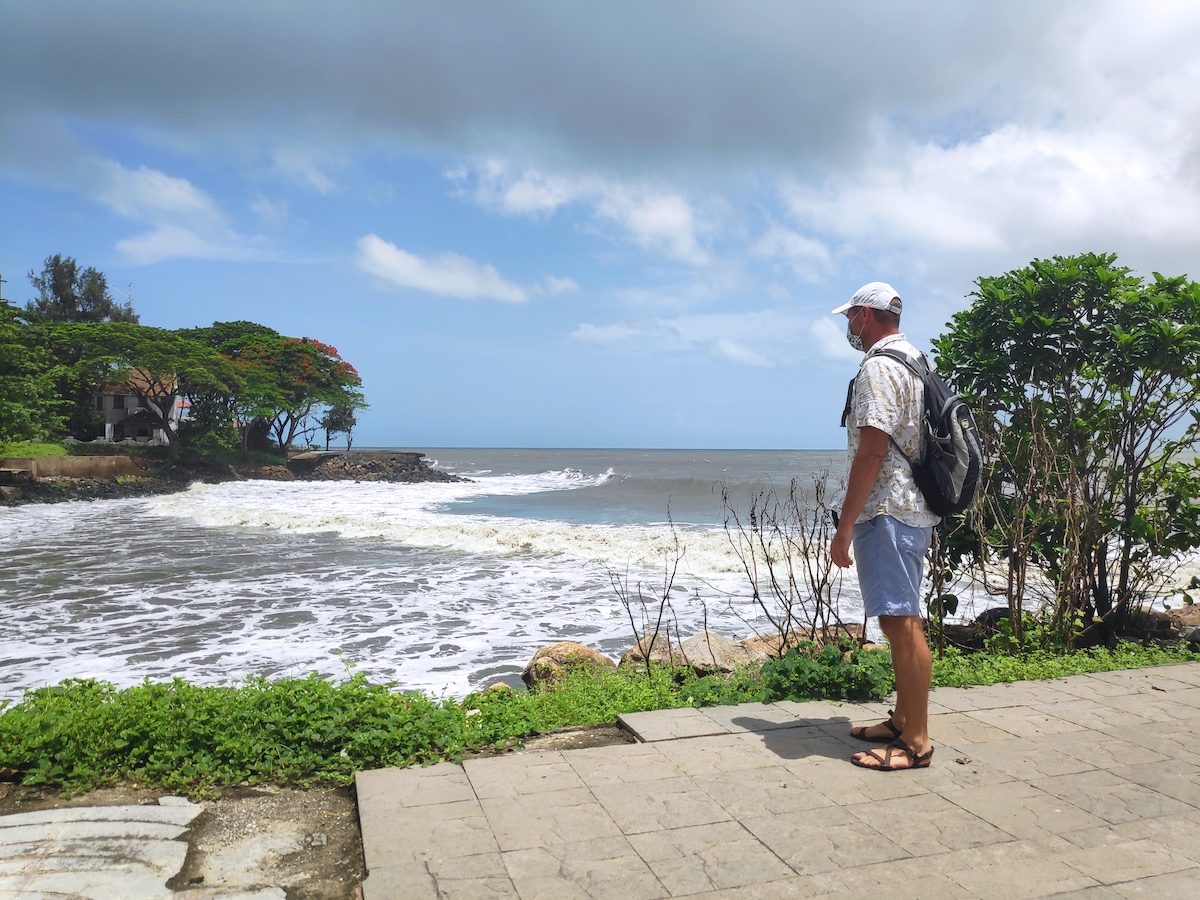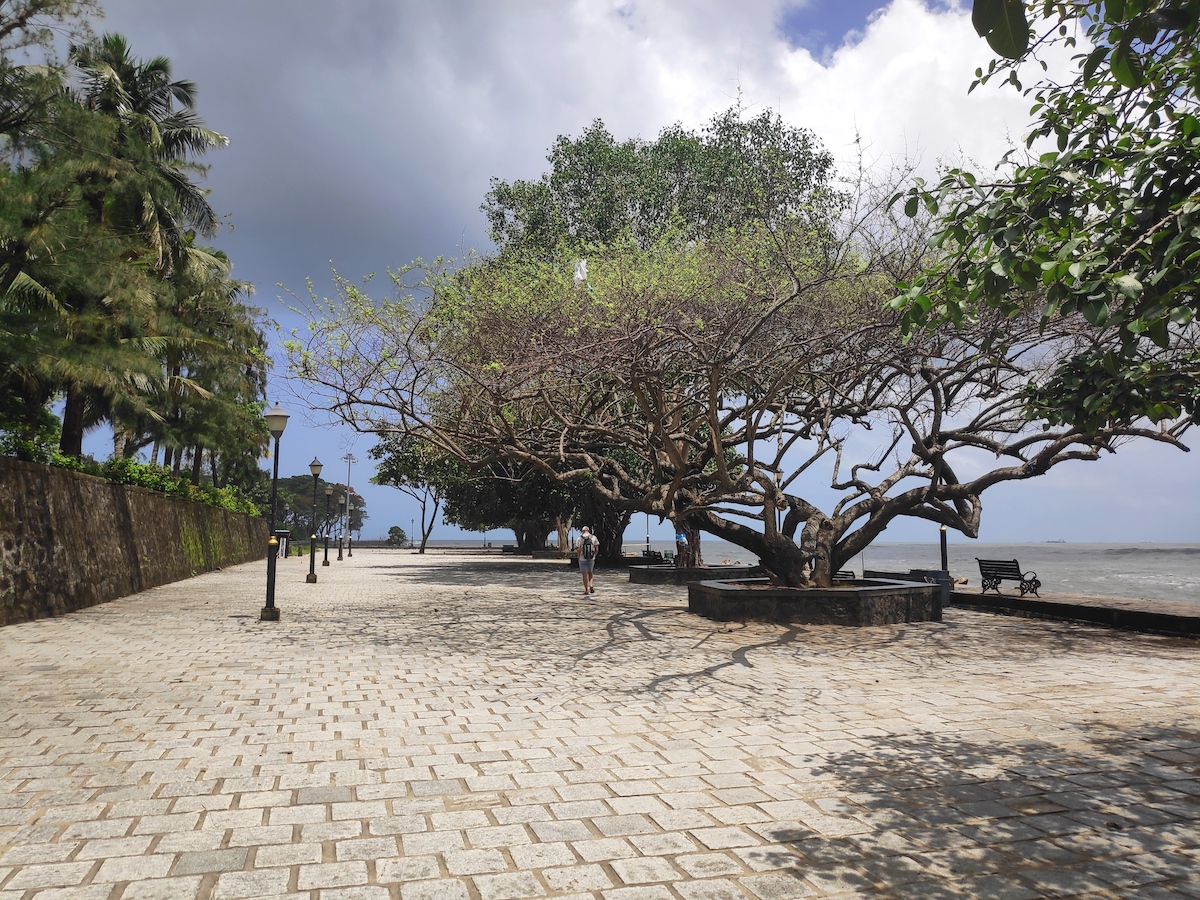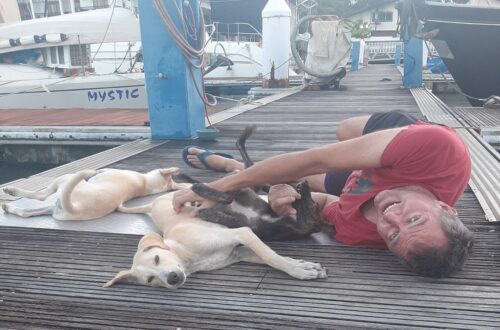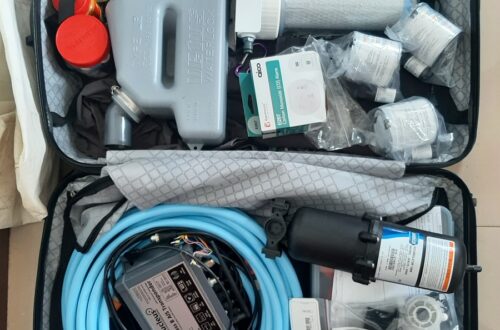
Unlocking Tiny Living
On June 8th, 2020 India moved from Lockdown 4.0 to Unlock 1.0. To save you working it out, that’s a total of 77 days of movement restrictions. 77 days where we have restricted our movement to the boat and the marina. In that whole time, we made only 6 excursions into the outside world – 1 to the ATM, 2 to the vets, 2 to the liquor store and 1 trip to the lab supplies store. Each of these was a there and back mission heading directly to our destination, completing our task and returning immediately. Only towards the end of lockdown were we able to go into a cafe to collect a takeout meal just before our return to the boat.
Much of the time during lockdown has been spent on the boat. Our living space is small. It is tiny living in the extreme. If the boat were a perfect rectangle, we would have 42sqm of living space. It is not, and this makes it difficult to accurately calculate how much actual living space we do have but I would half this. Aroha is a beamy boat, or as we refer to her our fat bottomed girl. The corona kilos that have been added during lockdown mean that I have to double-check that Bryan is referring to the boat not me when this expression is used but, in Aroha’s case, it means that she is a generous 3.8m wide at her widest point (the beam). Our main living space, the saloon, by rough calculation gives us about 14 sqm of liveable space. You may be encouraged to know this is above the legal floor space requirements for a prison cell in the UK – apparently, 5.4sqm per person is the minimum. And, as Bryan reflected when I mentioned this fact to him, another positive thought is that neither of us is in solitary confinement. Within this space is sofa-style seating that can comfortably seat 6 adults, a large fold-out centre dining table, the kitchen, and the navigation table. As with all boats, storage is provided in every nook and cranny with large storage lockers under and behind the sofas, along with a reasonable amount of cupboard space, and extra storage under the floor in the bilges – a handy place to store the liquor!
Living in such a small space does require a significant amount of discipline in terms of what we keep on board and how we use the space available to us. Bryan and I tend to have preferred seating spots onboard – Bryan on the starboard side, because he is always right (!), and mine on the port. This generously gives us a sofa each. I tend to do my laptop work sitting at the navigation table, Bryan opts for the dining table. All the kitchen-related storage is on the port side so relatively easy to access unless Bryan decides he wants to swap sides for a change of scenery. The only passageway through to the fore cabin is on the port (left) side. We occasionally end up doing a bit of a tango if we both try and access this space at the same time, but we tend to be quite well synchronised with a one at a time rule. Early in the planning of how we were going to use the space available to us, we split the wardrobe space in the forward and aft cabin into his and hers. Bryan keeps all his clothes in the forward cabin, and mine are in the back cabin. These are the spaces we tend to use as dressing areas also. This helps us avoid both needing to use the same space at the same time.
The challenge comes when this liveable space has to double up for other purposes, namely for engineering, mechanical or carpentry purposes – to name but a few. The toolboxes that live snugly underneath the port sofa take up residence on top of the sofa and the dining table becomes the workshop bench. Recently we actually ate our breakfast with our plates on top of the bathroom door that was being revarnished while horizontal on the dining room table. These jobs are thankfully fairly short-lived and, eventually, everything gets re-homed.
We have outside space too though, with the Indian climate outside and the luxury of air-conditioned comfort inside, we have tended not to use it much. Just before lockdown commenced, we had new cockpit cushions made. Our old ones were well worn after over 10 years of use though, ironically, we can’t quite bring ourselves to bring the new ones into commission. Their clean, bright newness is still something to be cherished. Once we are in less sweaty outdoor conditions they will be in full use.
Though we have only been full time living aboard since November last year, we have been actively downsizing over the past 4 years. As each of the kids left home for University, we took the opportunity to move into smaller accommodation, ending up in a 1-bedroom apartment as our final land-based home in Dubai. Over time we had drastically cut down on the amount of “stuff” we owned and began to appreciate how little we actually need. It has also meant that we keep only what we have a use for and buy far less. Our increasing understanding of the environmental damage caused by much of what we buy, including plastics and clothing high on the list, has also encouraged us to be more minimalist in our consumer habits. The conclusion of all this means that we really don’t feel that we are missing out on anything, or craving a bigger space to be locked down in. In fact, we consider ourselves to be extremely fortunate having a safe, secure space that we can call our own that gives us all the home comforts that we need. One positive coming from COVID is that we have recalibrated what makes us happy, and we have determined that it is the simple things that matter most.
Before lockdown, we were spending relatively little time on the boat, as we took advantage of exploring India by land. We had reached the conclusion that we had vastly underestimated the scale of this country and quite how much there is to see. What we did manage to achieve, mainly south India, gave us just a small taste of how diverse this country is. Wherever we travelled, and as much as we enjoyed these trips away, we were always happy to get back to the boat. Little did we know then that we would soon be spending quite so much time aboard!
So, when Unlock 1.0 was announced, we did not feel a huge need to rush back to the outside world. Our enthusiasm was also tempered because COVID cases in India continue to rise. Kerala has managed much better than other Indian states but, with Indians returning from overseas and other states within India, the number of positive cases has started to increase. For this reason, we have decided to just have one short trip out each week. For our first trip out, and with ferries and Ubers running again, we opted for a trip across to Fort Kochi. Under Unlock 1.0 malls, hotels, restaurants and places of worship can reopen so long as they follow guidelines for sanitation and social distancing. This meant that we could also visit one of our favourite cafes and enjoy a dine -in meal.
There are a couple of ferry routes across to Fort Kochi. Our preferred one is on the car ferry that crosses from Vypin to Fort Kochi several times an hour, and the crossing is just 5 minutes. There were noticeably fewer people on the ferry than pre-lockdown and no queuing at all to get at a ticket. Once we reached Fort Kochi, other than the rows of rickshaw drivers hoping for a fare, the corniche was mostly deserted. There were a few fishermen with their Chinese fishing nets, and a few determined stallholders open for business to sell juices and snacks but very little else. For each stall open there would be 5 that were not. We wondered whether the onset of the monsoon was the reason for the closure, and this was a normal seasonal event, or if this was due to COVID and lack of visitors to the island. We wandered along the water’s edge, looking out towards the Arabian Sea where we had sailed in from the UAE 6 months ago. It was strange to see so few people and we had mixed emotions both enjoying the tranquillity but also feeling sad for the changes that COVID has bought and the impact it has had on so many people’s lives and livelihoods.
At least we would be able to support one local business – the Loving Earth Cafe that had only launched just a few months before lockdown. It is now open again on limited days during the week. For the hour that it took us to have lunch, it felt almost normal. Our last dine-in experience anywhere was back in March, but the new normal meant that only every other table was in use and our waiter had face mask and gloves. We ordered far more than we needed from the menu, partly a celebration of the fact we were out and that there were so many delicious items to choose from, and all of them plant-based so nothing was off-limits. We polished off 3 main courses between us and then ordered a selection of desserts to take with us and share during sundowners on the marina later.
We headed back through the still deserted streets to get the ferry back to Vypin and arrived just as the heavens opened. With so few people around, there was a queue of waiting rickshaws to take us back to the Marina. Back on the boat, with the rain using the top deck as a drum, we settled down with a cup of tea and had a small test taste of the Millionaire Shortbread – delicious shortbread with Twix like topping – that we had bought back with us. We had had our first taste of freedom but were glad to be back on Aroha. Our tiny floating home and our sanctuary during these exceptional times.



















5 Comments
Dave Petty
Great story, thanks for creating the experience for us land-lubbers of living in the strict confines of an ultra small space. I could feel the release of pressure as you ventured further away than umbilical cord length for the first time. Thanks too for making me look up the meaning of ‘corniche’, I always thought it was just a Rolls Royce model.
Helen
Ha! Thanks Dave. We do tend to think we need more space than is really necessary, so thought it would be interesting to share. Glad to be of use developing your vocab too!
Wade Alarie
I’m glad to see that you’re making the most of a difficult situation. I would guess that you’ll be in Kochi for the “fully monty”, the wet season. We have arrived at Alanya Marina, Turkey and our Red Sea Passage is finished. It make take 6 months or more for this COVID-19 situation to settle down. I really enjoy your blog photos. 😉
Helen
Thanks for the comments and congratulations on making it to Turkey! The monsoon is pretty well established now and looks like we might be here for the duration – I think you may be right on the timeline for COVID situation settling! Plenty of worse places to be – so c’est la vie 🙂
Bryan
Hi Wade (and Diane), glad you’re enjoying the blog! I enjoy keeping up with your adventures (and boat work!) on your blog! B